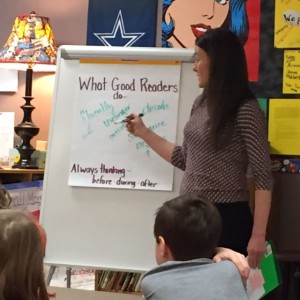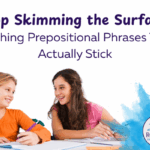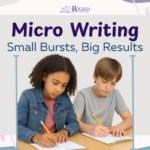 Through my many visits to schools and classrooms, I have realized that there is a myriad of ways the term “mini-lesson” is being used. It’s almost like the “old-fashioned” (according to my kids) game of telephone. A definition began, was passed to another educator, changed slightly, passed to another, and so on. As we start this school year, let’s go back to the source and the basics of mini-lessons.
Through my many visits to schools and classrooms, I have realized that there is a myriad of ways the term “mini-lesson” is being used. It’s almost like the “old-fashioned” (according to my kids) game of telephone. A definition began, was passed to another educator, changed slightly, passed to another, and so on. As we start this school year, let’s go back to the source and the basics of mini-lessons.
What Is It?
According to Lucy Calkins (1994), “Minilessons are a time to gather the whole class in the meeting area to raise a concern, explore an issue, model a technique, or reinforce a strategy” (p. 193). So, simply put, a mini-lesson is a time to gather everyone to teach key points in your curriculum.
Why Is It Important?
A mini-lesson gives everyone a common knowledge base. The topics in a mini-lesson not only teach the curriculum but they also give students knowledge of strategies that they will use throughout the year and longer. By following the features of a mini-lesson, the students will be actively engaged, have a clearer picture of expectations, and develop more confidence to attempt new strategies.
Key Features:
- SHORT. Mini-lessons, as the name suggests, are brief. It is important to understand that a child’s
 attention span is equal to their age in number of minutes, give or take a few. So take a moment and think about how long you actually have to teach your lesson. The biggest challenge I have had getting with helping teachers to teach in short mini-lessons is the concern that they won’t be able to cover everything. However, you would be surprised how much you can actually cover in a short amount of time! If you do go longer, the students are more than likely not paying attention anyway. So keep it short!
attention span is equal to their age in number of minutes, give or take a few. So take a moment and think about how long you actually have to teach your lesson. The biggest challenge I have had getting with helping teachers to teach in short mini-lessons is the concern that they won’t be able to cover everything. However, you would be surprised how much you can actually cover in a short amount of time! If you do go longer, the students are more than likely not paying attention anyway. So keep it short! - EXPLICIT. If you only have ten minutes or so for a mini-lesson, it’s best to be clear! It is important for your mini-lesson to get right to point. Through modeling, explanation, think-alouds, explain how, when, and why to use the skill or strategy. Be as transparent as possible. For more on explicit teaching, click here.
- FOCUSED. You only have a brief time and you need to be as clear as possible, so it is important to focus on ONE NEW skill/strategy at a time. Don’t try to teach more than one new skill because you simply don’t have the time. Feel free to spiral in skills that have already been taught, but one new idea at a time.
- TEACHER TIME. If the small amount of time in a mini-lesson already makes you nervous, this will really scare you: that whole time is not just for you! You will want to teach a focused, explicit lesson, but you also want the kids to do some processing during the mini-lesson. Your mini-lesson should not be a PowerPoint, it should be engaging and done in front of the students. Unpack your thinking for the students in front of them. Yes, you pre-planned what you were going to say about your thinking before you began (PLEASE take the time to do this! You will thank yourself later, promise.), but you are going to “open your brain” and show the kids how to use the skill or strategy while explaining your thinking. It’s not as easy as it sounds – practice at home. You might also have a text that serves as the mentor. This is when you create anchor charts. Anchor charts are created WITH the students in real-time (not bought from others online). In the picture above, I was getting a group of third graders to think through what good readers do. I had that title on my anchor chart when I came in. I modeled, by reading aloud for two minutes while demonstrating some reader moves (asking questions, rereading, thinking about why something happened, etc.). Then the students explained what they think good readers do and I wrote THIER ideas on the anchor chart.
- STUDENT TIME. After the model or demonstration, allow time for students to try the skill or strategy you’ve just shown them under your watchful eye and listening ear. Students can turn and talk about something specific, but make sure to listen to know if they are on track. Students can try to do the strategy before leaving the mini-lesson, again with you listening. In the reading mini-lesson, the students turned and talked about what strategies they use in reading and they had to choose one to focus on for the day. I held them accountable by having them write down their personal focus so I could check in with them and see how it was going.

STRUCTURE of a Mini-Lesson
-
- Connect. It is vital to get your students’ attention and focus it as soon as possible. This is the time to grab attention, share the goal, and attach to previous learning. So at the beginning of the mini-lesson, connect to something they already know. “Yesterday, we learned …”, “So far you learned …”, etc.
- Instruction. This is your clear, unambiguous lesson that contains a think-aloud, model, or demonstration of some kind.
- Engagement. In this time, all the students process and try out the new skill or strategy (or at least talk about it). We have to gradually release them to independent work.
- Link and Challenge. At the end of your mini-lesson link the lesson, or explain how this skill can be used beyond today in the classroom. “Strong readers will ask questions when they read the internet, or textbooks, or even books for fun because it helps them understand texts better and provides a deeper insight.” I also like to challenge the students. At this point, they will leave the mini-lesson to engage in the strategy themselves while I pull small groups or work one-on-one. So I provide a challenge to get them to use the new strategy and hold them accountable. “When you go back to your seat and begin reading your own book, I want you to think about asking questions as you read. When you ask a question, mark the page with a post-it.” At the end of reading time, I will stop the students and ask them to write down the question they had and the page number where it occurred in their journal. This information will help me see how each student is grasping the strategy as I collect their journals or conference with them later.
How is this similar or different to your mini-lessons?
Resources
Calkins, L. M. (1994). The art of teaching writing. Heinemann Educational Books Inc., 70 Court St., Portsmouth, NH 03801.


